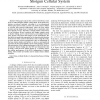Free Online Productivity Tools
i2Speak
i2Symbol
i2OCR
iTex2Img
iWeb2Print
iWeb2Shot
i2Type
iPdf2Split
iPdf2Merge
i2Bopomofo
i2Arabic
i2Style
i2Image
i2PDF
iLatex2Rtf
Sci2ools
GLOBECOM
2009
IEEE
2009
IEEE
Carrier to Interference Ratio Analysis for the Shotgun Cellular System
—This paper analyzes the carrier-to-interference ratio of the so-called shotgun cellular system (SCS). In the SCS, basestations are placed randomly according to a two-dimensional Poisson point process. Such a system can model a dense cellular or wireless data network deployment, where the base station locations end up being close to random due to constraints other than optimal coverage. The SCS is a simple cellular system where we can introduce several variations and design scenarios such as shadow fading, power control features, and multiple channel reuse groups, and assess their impact on the performance. We first derive an analytical expression for the characteristic function of the inverse of the carrier-to-interference ratio. Using this result, we show that the carrier-to-interference ratio is independent of the base station density and further, we derive a semi-analytical expression for the tail-probability. These results enable a complete characterization of the cellular perf...
| Added | 20 May 2010 |
| Updated | 20 May 2010 |
| Type | Conference |
| Year | 2009 |
| Where | GLOBECOM |
| Authors | Prasanna Madhusudhanan, Juan G. Restrepo, Youjian Liu, Timothy X. Brown |
Comments (0)

